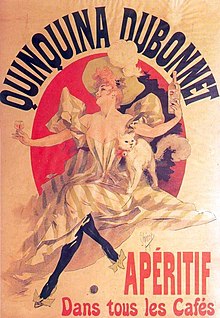Dubonnet

The Dubonnet is an aperitif sold for the first time by Joseph Dubonnet in 1846 , which is very similar to Vermouth .
The basis for Dubonnet is wine that is fermented with cinchona bark and other herbs and whose fermentation is stopped by adding alcohol. In the 19th century, cinchona bark was seen as a miracle cure against malaria and generally as a panacea and tonic. It was developed as a tonic by the Lyon doctor "Doktor Juppet" as early as 1830 . Cinchona bark was given to soldiers as prophylaxis at the time , which initially met with fierce opposition, because cinchona bark tastes extremely bitter. Liqueur manufacturer Dubonnet thought about a solution in 1846. He mixed mistletoe and spices with cinchona bark, which resulted in a slightly bitter, but extremely digestible drink. Not only soldiers, but also more and more Parisians liked the aperitif and christened it Quinquina Dubonnet . This made Dubonnet a pioneer of a fashion for aperitifs based on wine or grape must that were enriched with cinchona bark. The Dubonnet brand was taken over by Pernod Ricard in 1976 .
It is the favorite drink of the British Queen Elizabeth II , who mixes it with a third of Gordon's gin and serves it with half a lemon wedge and two ice cubes .
Web links
Individual evidence
- ↑ BBC documentary A Year with the Queen , Great Britain 2007, Original title: Monarchy: The Royal Family at Work (English)
- ↑ Jason Wilson: Dubonnet, in Sickness and in Health. The Washington Post, January 7, 2009, accessed January 18, 2009 .